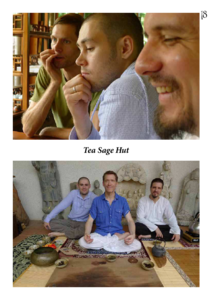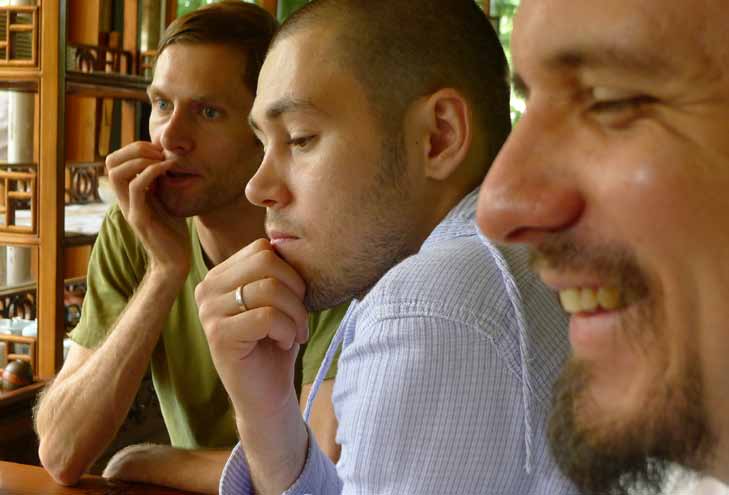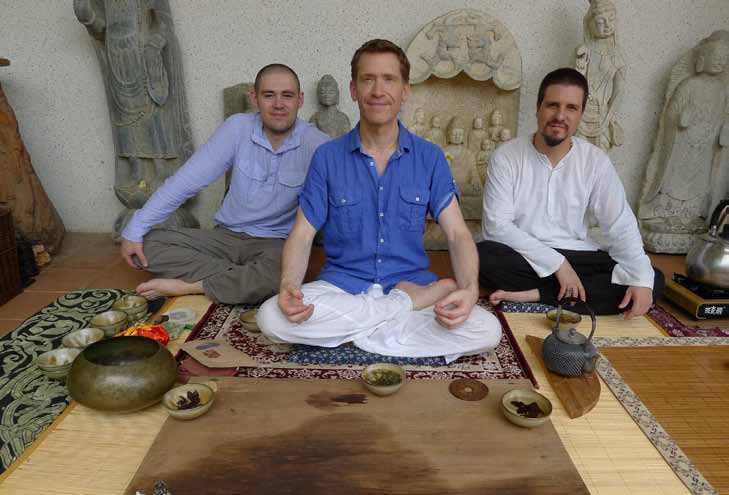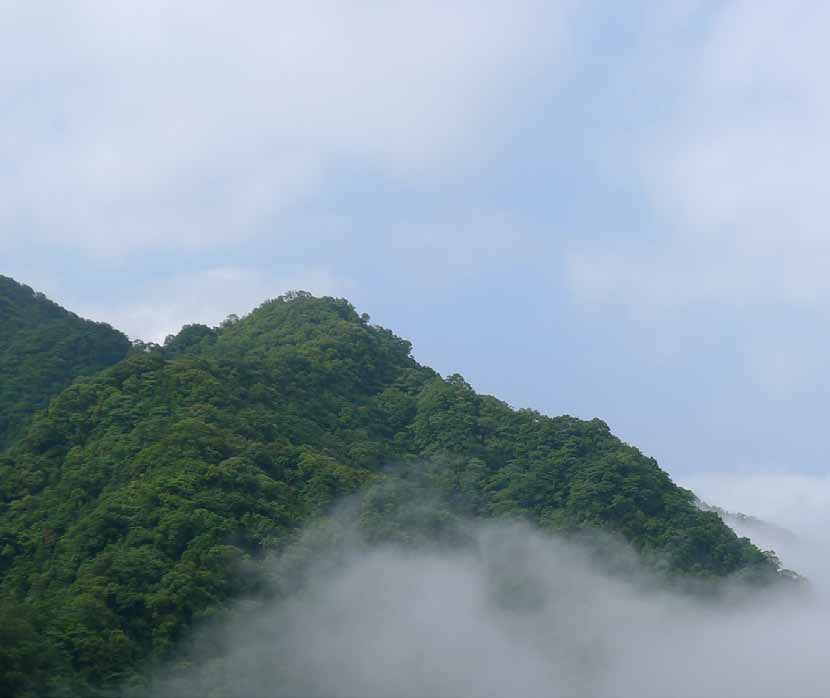
 |
|
Harmony through Alchemy We started this series last issue, but thought we could properly introduce it this time and then continue it each issue, focusing on an element each time.
"To know harmony is to know the Eternal, To know the Eternal is to cultivate insight."
Harmony through alchemy has always been central to the aesthetics and philosophy of tea culture, whether clearly expressed by ancient Daoist mendicants, or left unstated, yet recognized by the modern tea drinker who intuitively knows when a tea set functions well, when a tea is brewed properly, or when something in the process is off. The mixing and blending of figurative and material elements in tea truly is alchemical - both externally in the way the leaf, water, fire and teaware combine to form the liquor; and internally in the way we use the tea session to create peace, quiet and a stillness that inspires dialogue with Nature and the Dao. And harmony has always been the guiding principle of these processes, for it is the harmony of a tea set that makes it beautiful and functional, the harmony of a tearoom which inspires relaxation, and even the harmony of the leaf, water and teaware which combines to make the best liquor. In the exploration of tea and our own development towards mastery, harmony is the ideal that we must seek out, just as masters past and present have always done.

The best teas are those which are brewed in a place where all the elements are in harmony together. This needn't mean anything magical or difficult to understand: "harmony" might just refer to the way that the proper water, at the proper temperature, combines with the right kind of leaves in the right amount, all in the best teaware, etc. What could be more alchemical? More and more modern tea farmers, artists that craft teaware, and even tea drinkers are beginning to understand that harmony must guide their tea. In exploring the elements that go into a fine cup of tea, and the way in which a more harmonious approach can be achieved, we can learn not only how to develop and progress in Cha Dao, but how tea can be a part of a healthier, calmer and more productive lifestyle.
Since ancient times Chinese sages and seers have separated the material world into five elements called "Wu-shing (五行)": wood, earth, water, fire, and metal. These principal elements are extremely complicated, influencing all aspects of Chinese culture, philosophy and spirituality - from Daoism to Buddhism, Feng-shui, medicine and even tea. Lu Yu himself inscribed symbols representing the Wu-shing on all of his teaware, and spoke of the way they all combined fluently in the brewing of tea.
Traditionally, these elements represented much more than just material aspects of the universe. They were also processes, with fire representing temperature and earth representing yin energy for example, and much more. They guided the selection and construction of buildings, understanding of the seasons and agriculture, spiritual work and meditation as well as Chinese medicine.
For tea brewing, it isn't important that one understand the library of concepts and ideas behind the Wu-shing or even recognize all of the phenomena that these concepts refer to as they occur in Nature. In order to grow in tea and develop in Cha Dao, we only need to understand how each of these elements combine to make the greatest cup of tea, and the way they come together in our spirits so that drinking fine tea daily can become more than just a beverage or refreshment, but a Way of living in concordance with ourselves, with nature and ultimately with each other as well.

As an ongoing column, I thought that each issue we could explore one of the Wu-shing as it pertains to Cha Dao. One should remember that the elements flow in and through each other, so the earth and water are in the wood, the fire in the water, etc., and we're just separating them conceptually for the sake of discussion. In understanding each of these elements, we might begin to see how they can either make or break the overall harmony of our tea session and our approach to tea as a time for relaxation, quiet, insight or even just the desire to share good tea with family and friends.
The earth is feminine and accepting, and beyond comparing what's better or worse. In the Chinese elements, she is deep and spacious - receding and moving inward like the cracks and gorges that cover her. In tea, the earth element is the teaware. Teaware has always been primarily stoneware rather than clay, which means it is produced using ore that is processed into clay rather than river clay, which is softer and less porous. Porcelain and Yixing are both stoneware, for example.
We can learn so much from the earth element in tea. Teapots, unlike people, know when to be empty and when to be full. In the Dao De Jing, the Sage suggests that it is the space within things that makes them useful. A solid teapot could brew no tea. It is because the teapot is empty that tea flows through it. All of its power comes from the fact that it contains space, pregnant with the possibility of infinite teas. An empty pot has the potential to make any tea that will ever be, including the best or the worst cup ever. It is this same space that makes an empty page infinite, awaiting the brush strokes that will channel the formless into the world of form. The teapot does not condemn any of the tea that finds its way into its space, but rather enhances it all. No matter what tea comes, it is enhanced for having been brewed in this pot. Without such space, there is nowhere for the tea to meet the water and heat.
The best teaware enhances the tea and yet leaves no trace of itself. We look for teaware that is beautiful and also makes the tea smoother, rounder and more full-bodied. It should smooth out the rough edges of a tea, and help it reach its highest potential. The earth element grounds the tea session, and returns us to this moment no matter how far away we've drifted.
When choosing teaware, pay attention to the mouthfeel of the tea. Roll it on your tongue and see if the liquor is smoother and rounder in a particular pot or cup. Has the pot or cup enhanced the tea? Has it left it with a flavor of its own? Does the tea want to be in that pot? Is its essence distorted? This is a powerful way to start.
The earth is the meeting point of the fire, water and wood. It holds space for them to come together, and makes peace between them. Choosing teaware is often daunting, and it will take a lifetime to master. Start simple. Choose a nice bowl and go on from there. With pots, unglazed clays are ultimately better, but also more difficult to choose since the quality of the clay will have a much greater effect on the tea. Purple-sand stoneware from the city of Yixing has been married to tea for over five hundred years, and nothing can compare to it for preparing most teas. We plan to write some more about Yixing in coming newsletters. Cups are almost always porcelain, which is glazed. Porcelain is smoother, thinner and more comfortable touching our lips. It is also white, which allows us to appreciate the liquor's color. As time goes on, you can learn more about different materials, shapes and sizes and the effects they have on various teas. There is so much to explore, especially when you consider that many of the variables can change from tea to tea. This doesn't mean your tea must be complicated. You should only explore the world of teaware if you find it exciting to do so.

Like the earth, the pot or cup doesn't pick and choose. And no trace of our session is left in them. They know when to fill up and when to empty, and are therefore able to serve an infinite amount of tea. Actually, a single pot and cup could be used to serve tea to everyone on earth, and just because they so deeply understand the relationship between empty and full.